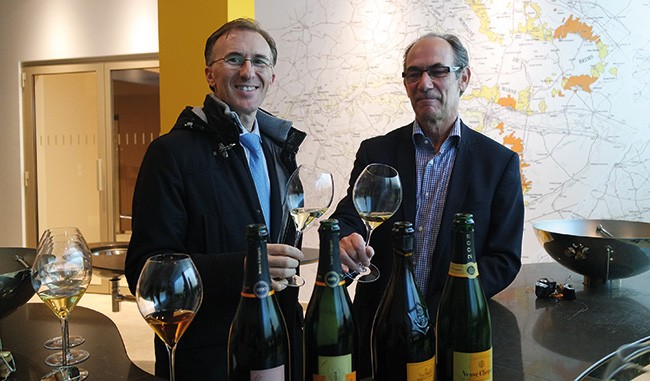
Could you tell us what defines the “Veuve Clicquot Spirit”?
For me, as an oenologist, what best defines the spirit of Veuve Clicquot, is the Carte Jaune cuvée. It is our most iconic cuvée, and the single best expression of our spirit and culture. It is our signature cuvée. And it happens to be the most difficult one to make. Its assemblage, dominated by Pinot Noir, is emblematic of Veuve Clicquot. It also contains about 30% Chardonnay, for freshness and elegance, and a light but essential touch of superb Pinot Meunier for roundness and seduction.
Just to give you an idea of how rich the blend is, let me remind you that Carte Jaune is made from seventy or eighty different crus. Which gives it a large horizontal dimension. But it also possesses an important vertical dimension since reserve wines play a major part in its blend. They can make up to 55 % of the blend and be from five or six different vintages.
At Veuve Clicquot we pay a lot of attention to aging. Varietals, plots and vintages are kept separately. We have what we call a “cuvothèque”, a still wine library, where some really old still wines are just waiting for their time. I often compare their role in a Champagne to that of spices in cooking. A simple touch can make a big difference, simply because of the subtleties it can reveal in the rest of the blend. For example we still have a tank of Cramant 1988, that one day will be used as the “spice” in Carte Jaune.
Beyond the assemblage, what can you tell us about the vinification and maturation processes?
At Veuve Clicquot all of our Champagnes go through malolactic fermentation. It has been done systematically ever since the process was identified. My job is to be faithful to our style and therefore I always let the “malo” take place. We do not use oak for aging, except for our vintage cuvées. Back in 2007, Dominique Demarville, our cellar master, bought large size butts, with a capacity of 50 to 70 hectoliters. We now use them to vinify about 10% of the blend of Vintage cuvées in order to give it just a little sweet and unctuous touch.
As far as Carte Jaune is concerned, the horizontal and vertical assemblages produce a Champagne for connoisseurs. It takes a certain knowledge of wine to appreciate its final notes especially its noble but bitter finish. It is a great Champagne altogether, where the power of the Pinot is balanced by the freshness of the Chardonnay.
In 2010 you introduced the Cave Privée range, what was your goal?
We were looking for ways to celebrate the bicentenial of the very first production of a vintage Champagne, back in 1810. So we came up with the idea of rewarding our most faithful customers by giving them access to our “oenothèque”. We decided to make available to them some collectors’ Champagne with a proven capacity to age. The first such vintage was a 1980, first disgorged in 1986. Some bottles had therefore aged an extra twenty years since. This double maturation, on the lees first, then on the cork, bring a rare harmony to the wine, which truly makes Cave Privée an exceptionnal collection.
What can you tell us about the 2016 harvest?
I am relieved and satisfied. The final days of summer were very nice and we enjoyed a real Indian summer afterwards, which allowed the grapes to fully ripen. It was a relief after catastrophic early months. The volumes are slightly below average, maybe down by 25%, but the quality is definitely there, and from a sanitary standpoint the grapes were perfect. From the very early tastings it could be a great vintage for Pinots.
What makes a great Champagne then?
To me a great Champagne is simply the kind of Champagne that has you say: “oh! my glass is already empty! I’d like to have another.”
Interview by Gérald Olivier